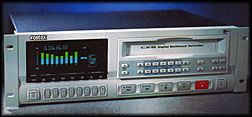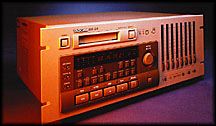
If you were one of the few lucky ones who managed to get their hands on an ADAT back then, you remember how incredible it was the first time you laid down some tracks and heard that superb CD-quality audio coming out of your monitors. If you're one of the thousands who put off buying a digital multitrack until they "worked the bugs out" or became more affordable, well that time is certainly here. Simply put, there's never been a better time to jump into the digital recording arena, whether it's with one of the great tape-based machines, or with one of the new breed of sophisticated hard disk recorders. Your only problem may be deciding which unit is right for your needs - gee, everyone should have such problems!
TAPE-BASED MULTITRACKS
Let's start out with the machine that started it all, the Alesis ADAT. Actually, the unit has now been updated and released as the second-generation ADAT XT ($3499 list price). The original ADAT sold over 70,000 units and, along with the DX-7 and M1 is probably one of the biggest success stories in music technology. The XT is actually less expensive than the original ADAT, yet it offers more than twenty new and improved features in addition to stunning sound quality. For starters, it fast-forwards and rewinds more than four times as fast as the original, as well as using advanced transport software to continuously monitor autolocation performance. The tape head constantly reads ADAT's built-in sample-accurate time code for super fast search and lock times. There's also a great new onboard digital editing function allowing users to make flawless copy/paste digital edits between machines, or even within a single unit.

As you probably already know, the ADAT format is built around an S-VHS videotape transport. That means you can buy tape just about anywhere in an emergency (but please, stick to the highest quality brands, like those we stock here at Sweetwater). All-in-all, the ADAT, having led the pack from the beginning, has evolved into an exceptional second-generation machine! Not long after Alesis began shipping ADATs, other manufacturers signed on to offer their own version of the S-VHS-based system. First to do so was Fostex with the RD-8, which added new control and sync functions (and is still being offered). Their new CX-8 ($3495 list) is more closely modelled after the ADAT XT (all you have to do is look at the front panel), but there are differences in connectors. The ADAT uses an ELCO/EDAC multipin connector, while a DB25 multipin connector is standard on the CX-8 for its +4 dBu balanced ins and outs (both machines have -10 dBv unbalanced ins/outs via RCA connectors).
Also based on the ADAT XT format is the new Panasonic MDA-1 ($3495 retail). Panasonic has long been renowned for its professional DAT recorders and video decks and now they've jumped into the multitrack market. The MDA-1, as you might guess, is almost identical to the ADAT, but offers standard XLR connectors to handle the +4 dBu balanced ins and outs (rather than the ADAT's ELCO connector), which may make it quite attractive to some studio owners. In addition, the XLRs are servo-balanced and capacitor coupled, a very nice bonus.

Hot on the heels of the original ADAT came the TASCAM DA-88 ($4799 list) which is based on a Hi-8 mm video format. The DA-88, with its host of video synchronization options, literally rules the audio post-production market (along with the DA-88-based Sony PCM-800). So impressed was the video community with this machine that it actually won an Emmy (!) for Outstanding Achievement in Technical Development. While there have been a number of internal upgrades to the unit, the original design has been so successful that the company has seen fit to simply continue manufacturing them, though the company will be releasing a new unit, the DA-38, this summer which is designed specifically for musicians.
As mentioned, the Sony PCM-800 ($5995) is also based on the DA-88 and its Hi-8 format. This unit takes its audio so seriously that there are no -10 dBv ins and outs at all, only +4 dBu via balanced XLRs (the unit also offers DB25 multipin ports for AES/EBU digital signals). At its price point, the PCM-800 is clearly aimed at high-end post-production facilities and video houses that want to maintain an "all-Sony" approach to their studio.
DISK-BASED MULTITRACKS
For ease-of-editing and fast random access starts and searches, there's nothing like a disk-based system. The only downside might be that once you used up all the space on a hard drive, well, you just had to get another one. Either that or find a way to back up all your data, then re-use your original disk. Several of these machines (as we'll see) are beginning to ship with Iomega's one gig removable media Jaz drive and all of them can use one.

Currently, there are several contenders for "top dog" in the disk-based multitrack world. E-mu Systems recently jumped headlong into the multitrack wars with its eight-track DARWIN hard disk recorder ($3195 retail). E-mu's philosophy was simple: make the machine as easy to use as a tape-based system with all the benefits and features of the finest hard disk systems. They've even integrated the Iomega Jaz drive in the model 4002 ($3995 list) for 190 minutes of recording time per removable cartridge.
Fostex recently introduced the DMT-8 Digital Multitrack ($1995 list), and they've put together a package that should delight virtually everyone, including an internal 540MB hard drive, easy editing (without data compression!), a flexible, 22 input mixer with parametric EQ, MIDI capabilities, jogwheel scrubbing (without pitch change), and six locate/cue points.
The new Roland VS-880 ($2495 list with 540 MB internal drive) also comes in a Jaz drive-equipped version ($2895 list). The unit is based on the company's great high-end DM-800 and features an integral 14-track fully-digital mixer plus 64 audio tracks (8 primary tracks plus eight layers of "virtual tracks" per primary). Finally, offering both 8- and 16-track hard disk machines is Akai Digital with their DR8 ($3495 retail) and DR16 ($4995 retail) Hard Disk Recorders. Akai has actually been shipping hard disk-based machines for longer than anyone, so it only makes sense that these guys build a great machine. With 24-bit internal processing, 16-channel digital mixer, built-in mic preamps and a list of features that would fill this page, you might want to give these units some serious consideration.
Which format is the best, tape or hard disk? That's all beyond the scope of this brief overview of today's multitrack market (and we haven't even touched on computer-based multitracks!). So for more meaningful insights into digital multitracks, great advice and special low pricing on the best machine for your particular needs (hey, we carry them all!), call your Sweetwater sales engineer today.